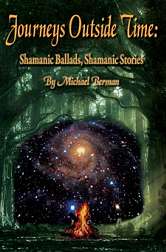Journeys Outside Time: A Collection of Shamanic Ballads and Shamanic Stories by Michael Berman
Michael Berman, UK
Author: Michael Berman
Price: £6.95p or $8.95 ISBN: 978-0-9843302-7-0
www.pendraigpublishing.com

SEE, your companions have gone;
Will you not too make a start?
If you desire to take wing as a bird,
Then leave to the vultures this carrion world.
Forsake your relations,
For your real Friend must be sought ...
The lines above are taken from The Secret Rose Garden of Sa’d Ud Din Mahmud Shabistari, rendered from the Persian by Florence Lederer. London: J. Murray [1920]. Sa'd ud Din Mahmud Shabistari was born in Persia, in Shabistar, near Tabriz, about 1250 CE. His best known work, The Secret Rose Garden is a set of verses that uses the rich Sufi allegorical language to explore the path back to God, the path back to what we originated from, the only real journey we ever take. And it is this journey outside time as we know it, which entails the search for the real Friend, this book is really all about.
The shamanic story can be defined as a story that has either been based on or inspired by a shamanic journey, or one that contains a number of the elements typical of such a journey. Characteristics typical of the genre include the way in which the stories all tend to contain embedded texts (often the account of the shamanic journey itself), how the number of actors is clearly limited as one would expect in subjective accounts of what can be regarded as inner journeys, and how the stories tend to be used for healing purposes. Shamanic ballads can be identified too, and it is these ballads that this collection mainly focuses on.
Encounter-narratives presented by cunning folk and witches, and recorded in early modern European witch trials, provide evidence to suggest that “popular shamanistic visionary traditions, of pre-Christian origin, survived in many parts of Britain during the early modern period” (Wilby, 2005, p.7). And these traditions can be found reflected in both our folktales and our ballads.
It has been suggested that even though they are given different cultural expression at particular times and places, the traits which underpin Siberian shamanism occur naturally in individuals throughout humanity (see Hutton, 2001, p.149). “The uncanny similarity between the encounter-experience of the early modern cunning folk and witches and those of nineteenth- and early twentieth-century Siberian and Native American shamans are therefore wholly in keeping with the trans-historical and trans-cultural congruity of shamanistic experience” (Wilby, 2005, pp.183-184).
Although it cannot be proved conclusively, given all the parallels between the experiences of cunning folk and witches and those of tribal shamans, it is highly likely that shamanism was once widely practised in pre-Christian Europe, and that we should have shamanic ballads that reflect this should therefore come as no surprise. They form part of “An oral legacy … as old as mankind and woven out of infinitesimal threads. A complex inheritance of magical beliefs and practices worked together over a millennia to form vivid and charismatic mythological and cosmological tapestries” (Wilby, 2005, pp.254-255). And it is a legacy to treasure and cherish, a legacy that the writing of this book is an attempt to both acknowledge and pay homage to.
References
Hutton, R. (2001) Shamans: Siberian Spirituality and the Western Imagination, London: Hambeldon & London.
Wilby, E. (2005) Cunning Folk and Familiar Spirits: Shamanistic Visionary Traditions in Early Modern British Witchcraft and Magic, Brighton: Sussex Academic Press.



|